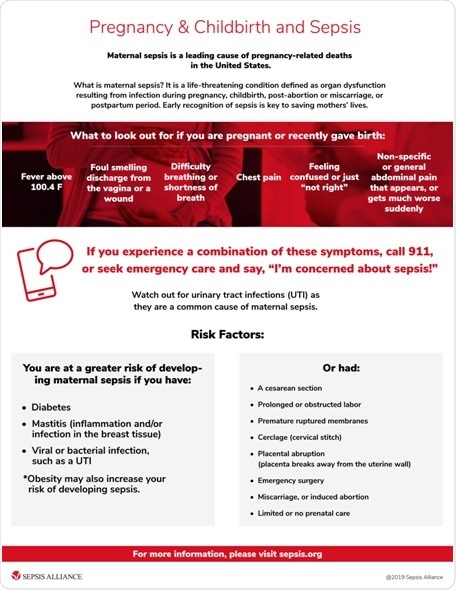
Sepsis Alliance launches Maternal Sepsis Day to raise awareness and save lives
On May 15, 2019, Sepsis Alliance, the nation’s leading sepsis organization, is launching Maternal Sepsis Day, an annual observance to raise awareness of the unique signs and symptoms of maternal sepsis, bring to life the personal experiences of the women who survived it, and remember those who have died.
Maternal sepsis is a life-threatening condition defined as organ dysfunction resulting from infection during pregnancy, childbirth, post-abortion or miscarriage, or the postpartum period. Maternal sepsis takes the lives of 261,000 women worldwide every year. In the United States, sepsis/infection is the third leading cause of pregnancy-related deaths.
Women who are pregnant or have recently given birth are at a greater risk of developing maternal sepsis if they have diabetes, mastitis, or a viral or bacterial infection, such as a UTI. Their risk also rises if they are obese. If a woman is pregnant, recently gave birth, or had an abortion or a miscarriage and she has a combination of two or more of the following symptoms, she should seek immediate medical attention and say: “I’m concerned about sepsis.”
The symptoms of maternal sepsis include:
- Fever above 100.4 degrees Fahrenheit
- Foul smelling discharge from the vagina or a wound
- Difficulty breathing or shortness of breath
- Chest pain
- Feeling confused or just “not right”
- Abdominal pain that appears, or gets much worse suddenly
Other risk factors for women who are pregnant or recently gave birth include, having a cesarean section, prolonged or obstructed labor, premature rupture membranes, cerclage (cervical stitch), placental abruption, emergency surgery, and limited or no prenatal care. Urinary tract infections (UTI) are a common cause of maternal sepsis.
Sepsis Alliance recently released a free downloadable infographic to help women who are expecting and who have recently given birth learn the signs and symptoms of maternal sepsis, the associated risk factors, and when to seek medical attention. In tandem, Sepsis Alliance released an online toolkit to help anyone raise awareness of maternal sepsis.
To help educate healthcare providers, Sepsis Alliance is collaborating with the Ohio Hospital Association to present the Maternal Sepsis Webinar. During this webinar, healthcare providers will learn how to recognize and treat maternal sepsis.
With the help of generous gifts from their supporters, Sepsis Alliance is working to produce a Maternal Sepsis Education Module to educate OB-GYNs, OB nurses, midwives, doulas, and all healthcare providers dedicated to women’s health about maternal sepsis.
Source:

No comments:
Post a Comment